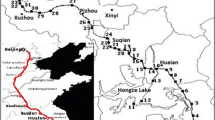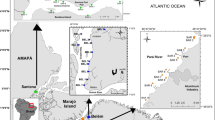Abstract
Concentrations of total aromatic hydrocarbons and extractable organic matter in the water column and sediment were determined in samples collected in the course of the last 20 years from the Salina Cruz Harbor, México, to assess the degree of organic contamination. In sediments, organic compounds accumulate in shallow areas mostly associated with extractable organic matter and fine fractions. Calculated geocumulation index and enrichment factors suggest that contamination could be derived from anthropogenic activities attributed to harbor and ship scrapping activities, as well as transboundary source. Concentration of total aromatic hydrocarbons (as chrysene equivalents) ranged from 0.01 to 534 μg l−1 in water, and from 0.10 to 2,160 μg g−1 in sediments. Total aromatic concentration of 5 μg g−1 is proposed as background concentration.
Similar content being viewed by others
References
APHA. American Public Health Association, American Water Works Association, and Water Pollution and Control Federation, 1995, Standard Methods for the Examination of Water and Wastewater, 1995, Total Suspended Solids Dried at 103°–105°C, American Public Health Association, Method 2540D, Washington, D.C. 2-56.
Barrick, R. C. (1982). Flux of aliphatic and polycyclic aromatic hydrocarbons to Central Puget Sound from Seattle (Westpoint) primary sewage effluent. Environmental Science and Technology, 16, 682–692.
Botello, A. V., Villanueva, S. F., Diaz, G., & Escobar-Briones, E. (1998). Polycyclic Aromatic Hydrocarbons in Sediments from Salina Cruz Harbor and Coastal Areas, Oaxaca, Mexico. Marine Pollution Bulletin, 36, 554–558.
Bouloubassi, I., & Saliot, A. (1993).Investigation of anthropogenic and natural organic inputs in estuarine sediments using hydrocarbon markers (NAH, LAB, PAH). Oceanologica Acta, 16, 145–161.
Chaudhuri, P., & Marron, J. S. (1999). Sizer for Exploration of Structure in curves. Journal of the American Statistical Association, 94(447), 807–823.
Chelton, D. F., Freilich, M. H., & Esbensen, S. K. (2000). Satellite observations of the wind jets off the Pacific Coast of Central America. Part II: Regional Relationships and Dynamical Considerations Monthly Weathers Review, 128, 2019–2043.
Chesler, S. N., Cub, B. H., Hertz, H. S., May, W. W., Dyszel, M., & Enagonio, D. P. (1976). Trace hydrocarbons analysis. The National Bureau of Standards, Prince William Sound/North Easter Gulf of Alaska. Base line study, Washington, D.C.
Digital River, Inc. (2005). Curve Expert 1.3 Software, available at http://www.digitalriver.com.
Eganhouse, R. P., & Kaplan, I. R. (1982). Extractable organic matter in municipal wastewaters. 1. Petroleum hydrocarbons: Temporal variations and mass emission rates to the ocean. Environmental Science and Technology, 16, 180–186.
Folk, R. L. (1974). The petrology of sedimentary rocks. Austin, Texas: Hemphill.
García-Ruelas, C., Botello, A. V., Ponce-Vélez G., & Díaz-González G. (2004). Polycyclic aromatic hydrocarbons in coastal sediments from the subtropical Mexican Pacific. Marine Pollution Bulletin, 49, 514–519.
Godtliebsen, F., Olsen, L. R., & Winther, J-G. (2003). Recent developments in statistical time series analysis: Examples of use in climate research. Journal Geophysical Research, 30(12), 1654–1657.
Gold, G., Acuña, J, & Morell, J. (1987). Manual CARIPOL/IOCARIBE para el análisis de hidrocarburos de petróleo en sedimentos y organismos marinos. Cartagena de Indias, Colombia.
González-Macías, C., Schifter, I., Lluch-Cota, D. B. Méndez-Rodríguez, L., & Hernández-Vázquez, S. (2006). Distribution, enrichment and accumulation of heavy metals in coastal sediments of Salina Cruz Bay, México. Environmental Monitoring and Assessment, 118, 1–3.
Gordon, D. C., & Keizer, P. D. (1976). Estimation of petroleum hydrocarbons in sea water by fluorescence spectroscopy. Improved sampling and analytical methods. Technical Report No. 481. Canada: Fisheries and Marine Service.
Holmström, L., & Erästö, P. (2001). Using the SiZer method in Holocene temperature reconstruction. Research Reports A36, Rolf Nevanlinna Institute. Finland: University of Helsinki.
Jeng, W. L., & Han, B. C. (1994). Sedimentary coprostanol in Kaohsiung harbor and the Tan-Shui estuary, Taiwan. Marine Pollution Bulletin, 28, 494–499.
Karichknoff, S. W., Brown, D. S., & Scott, T. A. (1979). Sorption of hydrophobic pollutants on natural sediments. Water Research, 13, 241–248.
King, A. J., Readman, J. W., & Zhou, J. L. (2004). Dynamic behavior of polycyclic hydrocarbons in Brighton marina, UK. Marine Pollution Bulletin, 48, 229–239.
Kot-Wasik, A., Dbska, J., & Namienik, J. (2004). Monitoring of organic pollutants in coastal waters of the Gulf of Gdansk, Southern Baltic. Marine Pollution Bulletin, 49, 264–276.
Latimer, J. S., & Quinn, J. G. (1996). Historical trends and current inputs of hydrophobic organic compounds in an urban estuary: The sedimentary record. Environmental Science and Technology, 30, 623–633.
Massey, Jr., F. J. (1951). The Kolmogorov–Smirnov test for goodness of fit. Journal of the American Statistical Association, 46, 68–78.
Massoud, M. S., Al-Abdali, F., Al-Ghadban, A. N., & Al-Sarawi, M. (1996). Botton Sediments of the Arabian Gulf-II.TPH and TOC contents as indicators of oil pollution and implications for the effect and fate of the Kuwait Oil Slick. Environmental Pollution, 93, 271–284.
Means, J. C., Wood, S. G., Hassett, J. I., & Banwart, W. L. (1980). Sorption of polynuclear aromatic hydrocarbons by sediments and soils. Environmental Science and Technology, 14, 1524–1528.
Müller, G. (1979). Schwermetalle in den sediments des Rheins-Veranderungen seitt 1971. Umschan, 79, 778–783.
Mzoughi, N., Dachraoui, M., & Villeneuve, J. P. (2005).Evaluation of aromatic hydrocarbons by spectrofluorometry in marine sediments and biological matrix: What reference should be considered? Comptes Rendus Chimie, 8, 97–102.
NFESC (2003). Final implementation guide for assessing and managing contaminated sediment at navy facilities. User’s Guide UG-2053-ENV. Naval Facilities Engineering Command. Washington, DC 20374-5065.
Nolting, R. F., Ramkema, A., & Everaats, J. M. (1999). The geochemistry of Cu, Cd, Zn, Ni and Pb in sediment cores from the continental slope of the Banc d’Arguin (Mauritania). Continental Shelf Research, 19, 665–691.
Readman, J. W., Bartocci, J., Tolosa, I., Fowler, S. W., Oregioni, B., & Abdulraheem, M. Y. (1996). Recovery of the coastal marine environment in the Gulf following 1991 the war related oil spills. Marine Pollution Bulletin, 32, 493–498.
Readman, J. W., Fillmann, G., Tolosa, I., Bartocci, J. Villeneuve, J. P., Catinni, C., et al. (2002). Petroleum and PAH contamination of the Black Sea. Marine Pollution Bulletin, 44, 48–62.
Roach, A. C. (2005). Assessment of metals in sediments from Lake Macquarie, New South Wales, Australia, using normalization models and sediment quality guidelines. Marine Environmental Research, 59, 453–472.
Statistica (1998). Statistica for windows (Vol I). General Conventions General Conventions ands Statistics I (2nd ed.). StatSoft, Inc., Tulsa OK, USA.
Surfer ® version 8.01 (2002). Golden Software, Inc., CO, USA.
Taylor, S. R. (1964). Abundance of chemical elements in the continental crust; a new table. Geochimica Cosmochimica Acta, 28, 1273–1285.
Tolosa, I., de Mora S. J., Fowler, S. W., Villeneuve, J. P., Bartocci, J., & Cattini, C. (2005). Aliphatic and aromatic hydrocarbons in marine biota and coastal sediments from the Gulf and the Gulf of Oman. Marine Pollution Bulletin, 50, 1619–1633.
Trasviña, A., Barton, E. D.,Brown, J.,Velez, H. S.,Kosro, P. M., & Smith, R. L. (1995). Offshore wind forcing in the Gulf of Tehuantepec, México. The asymmetric circulation. Journal of Geophysical Research, 100(20), 649–663.
United States Environmental Protection Agency (USEPA) (1978). Test method for evaluating total recoverable petroleum hydrocarbon, method 418.1 (spectrophotometric, infrared). Washington, DC: U.S. Government Printing Office.
United States Environmental Protection Agency (USEPA) (1996). Method 8440, total recoverable petroleum hydrocarbon by infrared spectrophotometry. SW-846 (3rd edn.). Revision-0. Washington, DC: U.S.Government Printing Office.
UNESCO (1982). Comisión Oceanográfica Intergubernamental Determinación de los hidrocarburos de petróleo en los sedimentos. Manuales y Guías, 11, 1–35. Place de Fontenoy, París, Francia.
UNESCO (1984). Comisión Oceanográfica Intergubernamental Manual para la vigilancia del aceite y de los hidrocarburos del petróleo disueltos o dispersos en el agua del mar y en las playas. Procedimientos para el componente petróleo del sistema de vigilancia de la contaminación del mar (MARPOL-MON-P). Manuales y Guías, 13, 1–37. Place de Fontenoy, París, Francia.
Volkman, J. K., Holdswoeth, D. G., Neill, G. P., & Bavor, H. J. (1992). Identification of natural, anthropogenic and petroleum hydrocarbons in aquatic sediments. The Science of Total Environment, 112, 203–219.
Zsefer, P., Glasby, G. P., Sefer, K., Pempkowiak, J., & Kaliszan, R. (1996). Heavy-metal pollution in superficial sediments from the southern Baltic Sea off Poland. Journal of Environmental Science and Health, 31A, 2723–2754.
Author information
Authors and Affiliations
Corresponding author
Rights and permissions
About this article
Cite this article
González-Macías, C., Schifter, I., Lluch-Cota, D.B. et al. Environmental Assessment of Aromatic Hydrocarbons-Contaminated Sediments of the Mexican Salina Cruz Bay. Environ Monit Assess 133, 187–207 (2007). https://doi.org/10.1007/s10661-006-9572-3
Received:
Accepted:
Published:
Issue Date:
DOI: https://doi.org/10.1007/s10661-006-9572-3




